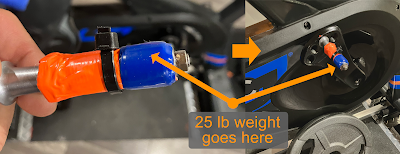Stages SB20 - Measuring Torque Against Factory Specifications
Torque Measurement
I previously documented how to compare SB20 power meters with a set of calibrated pedals. It gives you a good indication of how your power meters compare in actual riding scenarios.
This test statically measures torque with a pair of fixed weights. It tells you if your power meters meet factory specifications.
This test does not provide the full calibration that you can perform with Garmin or Favero pedals. You can't change offset or slope parameters to get the Stages PM measure correctly in the future.
Basic Testing Procedure
With equal weights on each side, cranks can be easily rotated to measure force at each pedal spindle.
Why 25 lb (11.24 kg) weights? Bike power meters commonly measure the equivalent of hundreds of pounds of force. It is impractical to test with weights that heavy. 100 lb weights are ideal. Unfortunately, they are big and don't allow cranks to fully rotate. Conversely, weights lower than 25 lb may not fully stress the power meters. 25 lb is a good compromise.
Some Assembly Required
To support the weights, you will need pedal spindles from an old (or new if you prefer) set of pedals. Here's one of my disassembled 1985 SPD road pedals.
I added tape to the spindles to help hold the weights. Zip ties help position the weight properly near the end of the spindle.
Use the spindles to replace your existing pedals.
Don't forget, the left pedal has reverse threads.
Here's how to remember: One Crank has Reversed Threads - Which one?
Using the StagesPower app
Zero Reset
Summary
1. Rotate cranks to wake them up. Set to vertical position. Open the StagesPower app.
2. The main page is shown. Press the Connect with Bluetooth button.
3. The Connect page is shown. Select both cranks. Click Connect.
4. The Power/RPM page is shown. Wait for both cranks to be displayed as connected.
5. The Zero Reset page is shown. Press the Perform Zero Reset button. ADC numbers are updated.
Zero reset is now complete.
If you are interested, here's what zero reset does (it's not much): Power Meters - Zero Reset.
Weight Positioning
Test Left Crank
Summary
1. Rotate cranks. Position the left crank horizontally in the forward position.
a. You can optionally use a level to ensure the cranks are horizontal.
2. Return to the StagesPower Connect page. Select the left crank. Click Connect.
3. The Power/RPM page is shown. Wait for the left crank to be displayed as connected. Press and hold the blank area below the Tools button.
4. The Torque / Force page is shown. Press the Start button.
5. Testing starts. The Torque and Force fields are repeatedly updated. Allow this test to run for 20 to 60 seconds and then press the Stop button.
6. Press the Email button. You can then send the .csv file created during the test to your email address.
The left crank has now been tested.
Test Right Crank
Open .csv files in a Spreadsheet
Here's a copy of the above spreadsheet, complete with formulas: SB20 Power Measurements.csv
Expected Torque Values
Torque (Nm) = Mass (kg) x gravity (9.81) x crank length (meters).
Torque (Nm) = 11.34 * 9.81 * crank length
Crank Length (mm) | ||||
165 | 170 | 172.5 | 175 | |
Torque (Nm) | 18.5 | 18.9 | 19.2 | 19.5 |
Making Minor Changes
Using the Stages Cycling app:
- You can raise power readings by increasing configured crank length. For example: if your actual crank length is 172.5 mm, you can try setting 175.0 mm.
- You can lower power readings by decreasing configured crank length. For example: if the your actual crank length is 172.5 mm, you can try setting 170.0 mm or lower.














Comments
Post a Comment